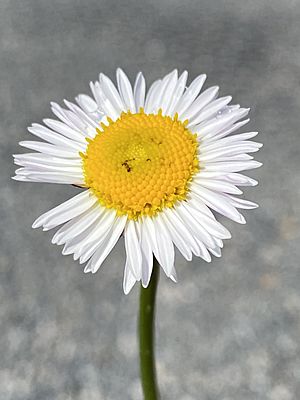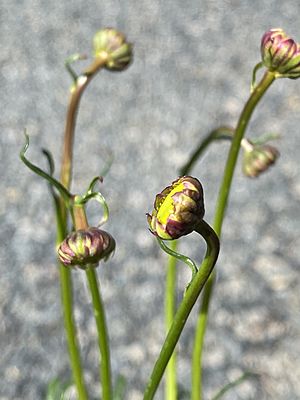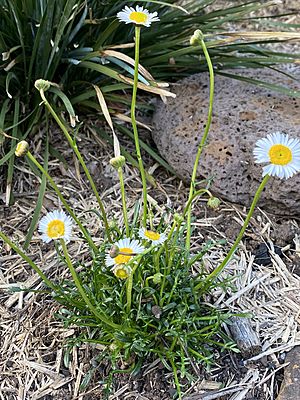Snow daisy facts for kids
Quick facts for kids Snow daisy |
|
|---|---|
 |
|
| Scientific classification | |
| Kingdom: | |
| (unranked): | |
| (unranked): | |
| (unranked): | |
| Order: | |
| Family: | |
| Genus: |
Brachyscome
|
| Species: |
B. nivalis
|
| Binomial name | |
| Brachyscome nivalis |
|
The snow daisy (Brachyscome nivalis) is a beautiful plant found only in Australia. It is a type of herb that lives for many years. This plant is known for its pretty white flowers that look like daisies, with bright yellow centers. Its leaves are also special, with deep cuts or lobes.
Contents
What Does the Snow Daisy Look Like?
The snow daisy is a perennial herb, meaning it grows back year after year. It has thin stems that can reach up to 30 centimeters (about 12 inches) tall.
Leaves of the Snow Daisy
The leaves of this plant are shiny and a bright green color. They grow in pairs, one on each side of the stem. They can be long and narrow, or a bit wider at the top, and they taper down towards the stem. These leaves can be up to 15 centimeters (about 6 inches) long. They often form a clump that looks like a rosette, which is a circular arrangement of leaves close to the ground. The edges of the leaves can be smooth or have deep cuts, making them look like feathers.
Flowers and Seeds
The snow daisy's flowers are white and grow one by one on their own stems. Each flower is quite large, about 3 to 4.5 centimeters (1.2 to 1.8 inches) wide. The stems holding the flowers can be 6 to 25 centimeters (2.4 to 9.8 inches) long. The white petals can be up to 12 millimeters (about 0.5 inches) long, and they surround a bright yellow center.
Around the base of the flower, there are small, leaf-like parts called bracts. These bracts are smooth and shaped like narrow spears with jagged edges.
After the flowers bloom, the plant produces small, dry, brown fruits. Each fruit is shaped like a wedge, flat, and about 2 to 3 millimeters (0.08 to 0.12 inches) long. They are covered with tiny, uneven hairs and often grow in bunches. Each of these fruits contains just one seed.
When Does it Flower?
Snow daisies usually bloom from summer to early autumn. However, if they are grown in gardens, they might start flowering earlier, sometimes in the spring.
How Was the Snow Daisy Named?
The snow daisy, Brachyscome nivalis, was first officially described in 1855. A famous botanist named Ferdinand von Mueller gave it its scientific name. He wrote about it in a book called Definitions of rare or hitherto undescribed Australian plants.
Where Does the Snow Daisy Grow?
The snow daisy is an endemic plant, which means it naturally grows only in certain parts of Australia. You can find it in the higher, colder areas of New South Wales. It also grows south from a place called Mount Gingera in the Australian Capital Territory.
In the state of Victoria, the snow daisy likes to grow in rocky spots that are protected from harsh weather. It can be found in alpine areas, sometimes in open fields with many herbs, in grasslands, and in woodlands.



